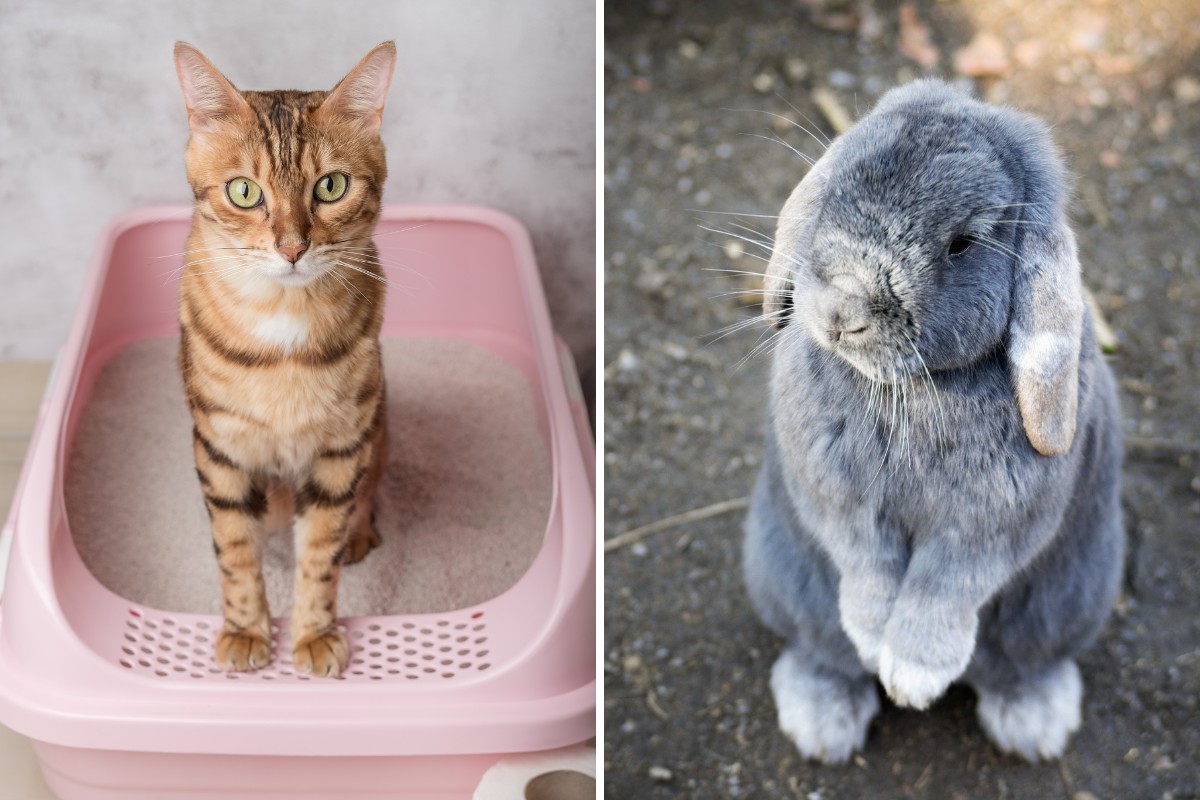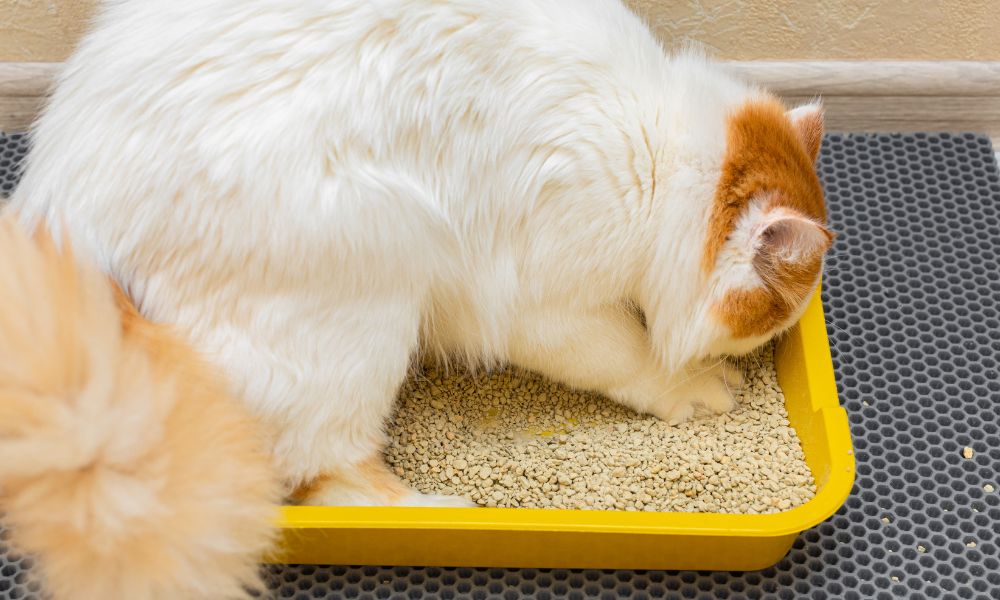 7 Nov
7 NovCan You Use Cat Litter for Rabbits?
If you’re a rabbit owner, you might be pondering whether cat litter is a viable option for your floppy-eared friend’s bedding. Having been in the trenches as a cat parent, I understand the lure of using what’s already on hand. But when it comes to our pets, especially ones as delicate as rabbits, it’s crucial to make informed choices about their living environment.
No, it is not recommended to use traditional cat litter for rabbits. Rabbits have different needs and sensitivities; cat litter, especially those that clump, contain silica, or are scented, can pose health risks such as respiratory problems, digestive blockages, and toxicity issues.
Safe alternatives for rabbit bedding include paper-based litters, aspen shavings, and barley or oat straw, which are more suitable for a rabbit’s delicate respiratory and digestive systems. Always choose bedding that is absorbent, dust-free, and free from chemicals or artificial fragrances to ensure your rabbit’s environment is safe and comfortable.
In this post, we’ll explore the specific needs of rabbits and why cat litter may not make the cut. We’ll look at safer alternatives that ensure the well-being of your furry companion. So, let’s get straight to the point and talk about whether cat litter is a safe bedding option for rabbits and what you should use instead.

The Risks of Using Cat Litter for Rabbits
Differences between Cat and Rabbit Digestive and Respiratory Systems
When considering bedding for your rabbit, it’s essential to recognize that cats and rabbits have very different physiological needs and sensitivities. Rabbits, for one, have a much more sensitive respiratory system compared to cats. Their lungs and airways can easily be irritated by dust and strong scents, which are often found in various types of cat litter.
Moreover, their digestive systems are equally delicate. Rabbits tend to nibble on anything in their reach, including their bedding, which is a behavior less commonly seen in cats. This nibbling habit means that what works for a cat could be harmful if ingested by a rabbit.
Specific Types of Cat Litter and Their Risks to Rabbits
1. Clumping Clay Litter
The clumping property of clay litter, which is so convenient for cat waste, poses a significant health risk to rabbits. If ingested, the clumping agents can expand inside a rabbit’s digestive system, potentially causing life-threatening blockages.
2. Silica Gel Crystals
Silica gel crystals are another popular cat litter choice because of their high absorbency and odor control. However, these tiny crystals can be incredibly harmful to rabbits if inhaled or ingested. The sharp edges may cause cuts and abrasions in the delicate respiratory and digestive tracts of rabbits.
3. Scented and Chemical-Added Litters
Scented litters, while pleasant for human noses and designed to mask odors, can be overwhelming to a rabbit’s far more sensitive sense of smell. The chemicals used to create these fragrances can also lead to respiratory distress or allergic reactions in rabbits.
Potential Health Issues from Using Inappropriate Cat Litters
1. Respiratory Problems
The dust from cat litter, especially those that are clay-based or have added fragrances, can lead to chronic respiratory issues in rabbits, such as sneezing, coughing, and in severe cases, respiratory infections or pneumonia.
2. Gastrointestinal Blockages
Rabbits’ gastrointestinal systems are specialized for processing high-fiber, low-nutrient food. When rabbits ingest cat litter, it can lead to blockages, a severe condition known as gastrointestinal stasis, which, if left untreated, can be fatal.
3. Toxicity Concerns
Many cat litter contain chemicals to reduce odor or increase clumping. When rabbits ingest these chemicals, they can suffer from various forms of toxicity, leading to an array of health problems, from liver damage to neurological issues.
Safe Bedding Alternatives for Rabbits
Selecting the right bedding for your rabbit is not just about comfort; it’s about health and safety. Fortunately, there are several safe alternatives to cat litter that will keep your rabbit cozy and healthy.
1. Paper-based Litters
Paper-based litter is an excellent choice for rabbit bedding. They are generally made from recycled paper and are free from inks or chemicals, making them safe if your rabbit decides to take a nibble. These litters are also highly absorbent, controlling odors naturally without the need for harmful additives.
They are soft, which means they won’t create abrasions on your rabbit’s sensitive paws. Plus, they are low in dust, which helps maintain a clean air environment for your rabbit’s respiratory health.
2. Aspen Shavings
Unlike pine or cedar shavings, which can be harmful to rabbits, aspen shavings are safe and a natural bedding alternative. They do not contain the aromatic oils found in other wood shavings that can cause respiratory and liver issues in rabbits.
Aspen is absorbent and provides a comfortable bed for your rabbit to lie on. It’s also a renewable resource, making it an environmentally friendly choice. However, it’s essential to ensure that the aspen shavings are dust-free to prevent any respiratory discomfort.
3. Barley or Oat Straw
Barley or oat straw can be a suitable bedding material for rabbits, as it’s natural and digestible. This means if your rabbit eats some of the straw, it won’t cause any serious health issues. Straw has good insulation properties, keeping your rabbit warm during the colder months.
It’s also relatively absorbent and needs to be changed regularly to prevent any dampness, as this can lead to mold growth and is not as absorbent as other options. When choosing straw, always opt for high-quality, dust-extracted varieties to ensure the health of your rabbit’s respiratory system.

How to Properly Set Up Rabbit Bedding
Setting up a comfortable and safe bedding area for your rabbit is crucial for its health and happiness. Here’s a straightforward guide to ensure you’re providing the best home for your furry friend.
Step-by-Step Guide on Setting Up Bedding
Choose a Spacious Enclosure: Your rabbit’s enclosure should be large enough for it to move around freely, stand on its hind legs, and stretch out.
- Select the Right Bedding: Choose from safe options like paper-based litter, aspen shavings, or barley/oat straw. Avoid materials harmful to rabbits such as pine or cedar shavings.
- Create a Layered Bedding: Start with a thin layer of a high-absorbency material like paper-based litter at the bottom to soak up urine. This helps to keep the enclosure dry and comfortable.
- Add Comfort Bedding: Place a thicker layer of softer bedding material such as aspen shavings or straw on top of the absorbent layer for added comfort.
- Provide Ample Bedding: Ensure there is enough bedding to nest and burrow, as rabbits enjoy these natural behaviors.
- Include a Nesting Box: If possible, place a nesting box filled with soft, dust-free hay within the enclosure. This allows your rabbit a cozy place to rest and retreat.
- Ensure Ventilation: Make sure the setup is in a well-ventilated area to prevent the buildup of ammonia from urine.
Cleaning Frequency and Maintenance Tips
- Spot Clean Daily: Remove soiled bedding and any waste daily to maintain a clean environment.
- Refresh Bedding: Partially change out the non-soiled bedding weekly to keep the area fresh.
- Deep Clean Regularly: Once a week, replace all bedding material. Clean the enclosure with a rabbit-safe disinfectant, and ensure it’s dry before adding new bedding.
- Wash Bowls and Bottles: Food bowls and water bottles should be cleaned daily to prevent the growth of bacteria.
Recognizing When Bedding Needs to Be Changed
- Odor: A noticeable smell is a clear indicator that it’s time to change the bedding.
- Dampness: Bedding that feels wet to the touch should be replaced immediately to prevent the growth of mold and bacteria.
- Discoloration: Look for signs of urine stains or fecal spots as signs that the bedding needs changing.
- Behavior Changes: If your rabbit seems uncomfortable or is avoiding certain areas of the enclosure, it might be due to dirty or inadequate bedding.
Frequently Asked Questions
Can rabbits use pellet cat litter?
Not all pellet cat litter is suitable for rabbits. Some are made with clumping agents or chemicals that can be harmful if ingested or cause respiratory issues. However, if you find a pellet litter that is made from 100% natural paper or wood without additives, it may be safe for use with rabbits. Always ensure the product is marked as safe for rabbits before using it.
How often should rabbit bedding be changed?
The bedding in the main living area should be spot-cleaned daily to remove soiled parts and replenish if necessary. A complete change of bedding should be done at least once a week. If you notice any odor or dampness, or if your rabbit is particularly messy, you may need to change it more frequently.
Can I use a newspaper for rabbit bedding?
While newspaper can be used as a bottom layer in your rabbit’s enclosure because it’s absorbent, it’s not the best option for the top layer that your rabbit will be in contact with. The ink from the newspaper can be harmful if ingested in large amounts, and newspapers don’t control odor well or provide comfortable bedding for your rabbit to rest on. If you do use newspaper, it should be covered with a safer, more comfortable material like hay, aspen shavings, or a paper-based litter.




